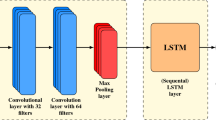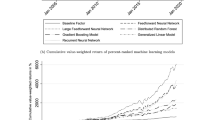Abstract
Volatility plays a crucial role in financial markets and accurate prediction of the stock price indices is of high interest. In multivariate time series, Dynamic Conditional Correlation (DCC)-Generalized Autoregressive Conditional Heteroscedastic (GARCH) is used to model and forecast the volatility (risk) and co-movement between stock prices data. We propose multivariate artificial neural networks (MANNs) hybridized with the DCC-GARCH model to forecast the volatility of stock prices and to examine the time-varying correlation. The daily share price data of five stock markets: S&P 500 (USA), FTSE-100 (UK), KSE-100 (Pakistan), Malaysia (KLSE) and BSESN (India) covering the period from 1st, January 2013 to 17th, March 2020 are considered for empirical analysis. Moreover, the hybrid models of MANNs and DCC-GARCH are developed in two ways: (i) MANNs is provided as an input to DCC-GARCH (1,1) producing a hybrid model of DCC-GARCH(1,1)-MANNs and (ii) DCC-GARCH(1,1) model is set as an input to MANNs resulting hybrid model of MANNs-DCC-GARCH(1,1). Furthermore, the performances of the proposed models are compared with single models via the root mean square (RMSE), mean absolute error (MAE) and relative mean absolute error (RMAE). The empirical results show that DCC-GARCH (1,1)-MANNs, a parametric model, outperforms both in-sample and out-sample forecasts and helps to examine the time-varying correlation and also provides volatility forecast as well, whereas the hybrid model MANNs-DCC-GARCH (1,1) provides forecast only. Therefore, the hybrid model of DCC-GARCH (1,1)-MANNs is found suitable as compared to MANNs-DCC-GARCH(1,1) to model and forecast the stock price indices under consideration.






Similar content being viewed by others
References
Engle RF (1982) Autoregressive conditional heteroscedasticity with estimates of the variance of United Kingdom inflation. Econometr: J Econom Soc. https://doi.org/10.2307/1912773
Bollerslev T (1986) Generalized autoregressive conditional heteroskedasticity. J Economet 31(3):307–327
Engle RF, Kroner KF (1995) Multivariate simultaneous generalized ARCH. Economet Theory 11(1):122–150
Bollerslev T (1990) Modelling the coherence in short-run nominal exchange rates: a multivariate generalized ARCH model. Rev Econ Stat. https://doi.org/10.2307/2109358
Engle RF, Sheppard K (2001) Theoretical and empirical properties of dynamic conditional correlation multivariate GARCH. National Bureau of Economic Research, Inc
Mohammadi H, Tan Y (2015) Return and volatility spillovers across equity markets in mainland China, Hong Kong and the United States. Econometrics 3(2):215–232
Bala DA, Takimoto T (2017) Stock markets volatility spillovers during financial crises: A DCC-MGARCH with skewed-t density approach. Borsa Istanbul Rev 17(1):25–48
Maraqa B, Bein M (2020) Dynamic interrelationship and volatility spillover among sustainability stock markets, major european conventional indices, and international crude oil. Sustainability 12(9):3908
Joshi P (2011) Return and volatility spillovers among Asian stock markets. SAGE Open 1(1):2158244011413474
Jebran K (2014) Dynamic linkages between Asian countries stock markets: evidence from Karachi stock exchange. J Manage Sci 3(5):1171–1198
Li Y, Giles DE (2015) Modelling volatility spillover effects between developed stock markets and Asian emerging stock markets. Int J Financ Econ 20(2):155–177
Jan W, Jebran K (2015) Empirical analyses of volatility spillover from G5 stock markets to Karachi stock exchange. Pak J Comm Soc Scien (PJCSS) 9(3):928–939
Jebran K, Iqbal A (2016) Examining volatility spillover between Asian countries’ stock markets. China Fina Econ Rev 4(1):6
Hamao Y, Masulis RW, Ng V (1990) Correlations in price changes and volatility across international stock markets. Rev Finan Stud 3(2):281–307
Koutmos G, Booth GG (1995) Asymmetric volatility transmission in international stock markets. J Int Money Financ 14(6):747–762
Song X (2009) Multivariate GARCH Models for the Greater China Stock Markets.
Xiao L, Dhesi G (2010) Volatility spillover and time-varying conditional correlation between the European and US stock markets. Glob Econ Finan J 3(2):148–164
Abbas Q, Khan S, Shah SZA (2013) Volatility transmission in regional Asian stock markets. Emerg Mark Rev 16:66–77
Asai M, McAleer M (2012) Dynamic conditional correlations for asymmetric processes. J Jap Statist Soci 41(2):143–157
Saiti B, Bacha OI, Masih M (2014) The diversification benefits from Islamic investment during the financial turmoil: the case for the US-based equity investors. Borsa Istanbul Rev 14(4):196–211
Ng SL, Chin WC, Chong LL (2017) Multivariate market risk evaluation between Malaysian Islamic stock index and sectoral indices. Borsa Istanbul Rev 17(1):49–61
Kaastra I, Boyd M (1996) Designing a neural network for forecasting financial. Neurocomputing 10:215–236
Gately E (1996) Neural networks for financial forecasting. Wiley, New York
Avcı E (2007) Forecasting daily and sessional returns of the ISE-100 index with neural network models
Fatima S, Hussain G (2008) Statistical models of KSE100 index using hybrid financial systems. Neurocomputing 71(13–15):2742–2746
Karymshakov K, Abdykaparov Y (2012) Forecasting stock index movement with artificial neural networks: the case of istanbul stock exchange. Trakya Üniversitesi Sosyal Bilimler Dergisi, Cilt 14 Sayı 2 (231–242)
Dixon M, Klabjan D, Bang JH (2017) Classification-based financial markets prediction using deep neural networks. Algorith Finan 6(3–4):67–77
Liu WK, So MK (2020) A garch model with artificial neural networks. Information 11(10):489
Fatima S, Uddin M (2017) Comparison of asymmetric garch models with artificial neural network for stock markets prediction, a case study. J Eng Appl Sci 36(1):51–58
Falat L, Stanikova Z, Durisova M, Holkova B, Potkanova T (2015) Application of neural network models in modelling economic time series with non-constant volatility. Procedia Econ Finan 34:600–607
Patel MB, Yalamalle SR (2014) Stock price prediction using artificial neural network. Int J Innovat Resear Sci, Eng Tech 3(6):13755–13762
Zhang GP (2003) Time series forecasting using a hybrid ARIMA and neural network model. Neurocomputing 50:159–175
Lu C-J (2010) Integrating independent component analysis-based denoising scheme with neural network for stock price prediction. Expert Syst Appl 37(10):7056–7064
Monfared SA, Enke D (2014) Volatility forecasting using a hybrid GJR-GARCH neural network model. Procedia Comp Sci 36:246–253
Lahmiri S (2017) Modeling and predicting historical volatility in exchange rate markets. Physica A 471:387–395
Hamdi M, Chkili W (2021) An artificial neural network augmented GARCH model for Islamic stock market volatility: Do asymmetry and long memory matter? Int J Islam Midd East Finan Manage. https://doi.org/10.1108/IMEFM-05-2019-0204
Bildirici M, Ersin ÖÖ (2009) Improving forecasts of GARCH family models with the artificial neural networks: an application to the daily returns in Istanbul stock exchange. Expert Syst Appl 36(4):7355–7362
Jin J, Kim J (2015) Forecasting natural gas prices using wavelets, time series, and artificial neural networks. PLoS ONE 10(11):e0142064
Lu X, Que D, Cao G (2016) Volatility forecast based on the hybrid artificial neural network and GARCH-type models. Procedia Comp Sci 91:1044–1049
Kim HY, Won CH (2018) Forecasting the volatility of stock price index: a hybrid model integrating LSTM with multiple GARCH-type models. Expert Syst Appl 103:25–37
Ramos-Pérez E, Alonso-González PJ, Núñez-Velázquez JJ (2019) Forecasting volatility with a stacked model based on a hybridized artificial neural network. Expert Syst Appl 129:1–9
Wutsqa DU (2008) The Var-NN model for multivariate time series forecasting. MatStat 8(1):35–43
Dietz S (2011) Autoregressive neural network processes-univariate, multivariate and cointegrated models with application to the German automobile industry
Aydin AD, Cavdar SC (2015) Comparison of prediction performances of artificial neural network (ANN) and vector autoregressive (VAR) Models by using the macroeconomic variables of gold prices, Borsa Istanbul (BIST) 100 index and US Dollar-Turkish Lira (USD/TRY) exchange rates. Procedia Econ Finan 30:3–14
Pendar M, Haji M (2017) Comparison of neural network models, vector auto regression (VAR), bayesian vector-autoregressive (BVAR), generalized auto regressive conditional heteroskedasticity (GARCH) process and time series in forecasting inflation in Iran. Int J Ind Math 9(2):119–128
Ramyar S, Kianfar F (2019) Forecasting crude oil prices: a comparison between artificial neural networks and vector autoregressive models. Comput Econ 53(2):743–761
McCulloch WS, Pitts W (1943) A logical calculus of the ideas immanent in nervous activity. Bull Math Biophys 5(4):115–133
Rosenblatt F (1958) The perceptron: a probabilistic model for information storage and organization in the brain. Psychol Rev 65(6):386
Rumelhart DE, Hinton GE, Williams RJ (1986) Learning representations by back-propagating errors. Nature 323(6088):533–536
Mcclelland JL, Rumelhart DE, Group PR (1986) Parallel distributed processing explorations in the microstructure of cognition, 2:216–271
Kuan C-M, White H (1994) Artificial neural networks: an econometric perspective. Economet Rev 13(1):1–91
Franses PH, Van Homelen P (1998) On forecasting exchange rates using neural networks. Appl Finan Econ 8(6):589–596
Zhang G, Patuwo BE, Hu MY (1998) Forecasting with artificial neural networks: the state of the art. Int J Forecast 14(1):35–62
Lam M (2004) Neural network techniques for financial performance prediction: integrating fundamental and technical analysis. Decis Supp Syst 37(4):567–581
Author information
Authors and Affiliations
Corresponding author
Ethics declarations
Conflict of interest
The authors declare that they have no conflict of interest.
Additional information
Publisher's Note
Springer Nature remains neutral with regard to jurisdictional claims in published maps and institutional affiliations.
Appendix 1
Appendix 1
1.1 ADF test of stationarity
Null and alternative hypothesis:
H0
Series contains a unit root.
H1
Series is stationary (Table
6).
1.2 ARCH–LM test of heteroscedasticity
Null and alternative hypothesis:
H0
No ARCH effect is present (Heteroscedasticity is not present).
H1
ARCH effect is present (Heteroscedasticity is present) (Table
7).
1.3 AIC and BIC (Table 8)
Rights and permissions
Springer Nature or its licensor holds exclusive rights to this article under a publishing agreement with the author(s) or other rightsholder(s); author self-archiving of the accepted manuscript version of this article is solely governed by the terms of such publishing agreement and applicable law.
About this article
Cite this article
Fatima, S., Uddin, M. On the forecasting of multivariate financial time series using hybridization of DCC-GARCH model and multivariate ANNs. Neural Comput & Applic 34, 21911–21925 (2022). https://doi.org/10.1007/s00521-022-07631-5
Received:
Accepted:
Published:
Issue Date:
DOI: https://doi.org/10.1007/s00521-022-07631-5




